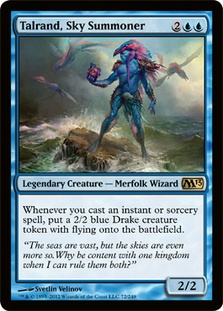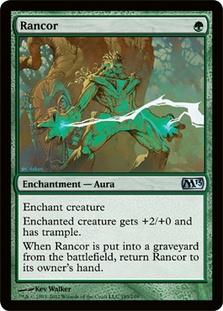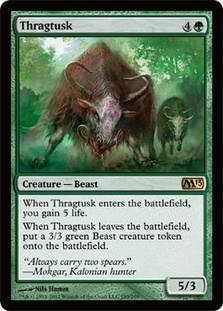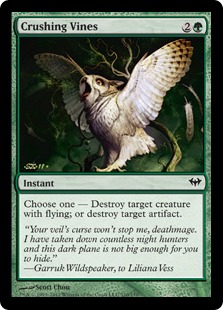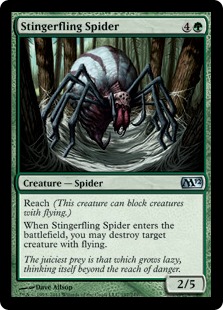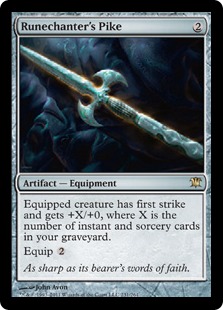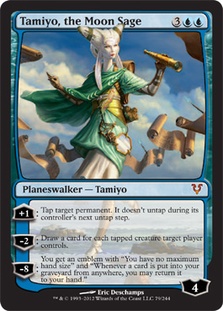It’s been a while since I have written about Standard. This is only because it has been quite a while since I actually played it. The last major event before the release of M13 was a WMCQ/PTQ weekend in Sydney where I played Martin Juza’s Naya deck in both events to a combined record of 2-4. I can’t blame him; he did tell me not to play it, but I liked its Delver matchup and it played good cards, so I played it anyway. I went 1-2 against Delver over the two events and didn’t have a good explanation as to why. I also lost numerous side events in different formats. I had a genuinely horrible Magic weekend and decided to take a bit of time off.
With the release of M13 on Magic Online, I was once again excited to play Standard. I really liked the look of Talrand, Sky Summoner, Rancor, and Thragtusk. The first deck I wanted to build was Mono-Blue Wizards. It didn’t take me long to realize that Talrand was a complete game changer against all of the Delver decks. You can use Cavern of Souls to resolve it, and once you do it just dominates. Delver of Secrets, Geist of Saint Traft, Restoration Angel, and Runechanter’s Pike all look pretty silly when there is a growing squad of 2/2 Drakes on the other side of the table.
Creatures (14)
Lands (19)
Spells (27)

While I was testing that, I thought I would also try decks with the other cards I liked from M13. I spent a bit of time on Kurt Crane’s G/W Elves, but I liked it a lot less than this version of Travis Woo mono-green deck that I had:
Creatures (34)
- 4 Llanowar Elves
- 4 Birds of Paradise
- 4 Elvish Archdruid
- 4 Arbor Elf
- 4 Primeval Titan
- 4 Palladium Myr
- 4 Avacyn's Pilgrim
- 1 Craterhoof Behemoth
- 4 Wolfir Silverheart
- 1 Thragtusk
Lands (22)
Spells (4)

I also built a Rancor–Hound of Griselbrand monstrosity:
Creatures (26)
- 4 Llanowar Elves
- 4 Birds of Paradise
- 2 Borderland Ranger
- 1 Viridian Emissary
- 4 Strangleroot Geist
- 3 Huntmaster of the Fells
- 2 Zealous Conscripts
- 1 Wolfir Silverheart
- 3 Hound of Griselbrand
- 1 Thragtusk
- 1 Thundermaw Hellkite
Lands (23)
Spells (11)

The non-Delver decks all had a number of things in common: they weren’t consistent, they couldn’t manipulate their draws to avoid mana screw or flood, they didn’t give you all that many ways to outplay your opponent, and they were simply just too green. It also felt like you had to side situational cards against Delver, which just made you even more inconsistent. You need to be able to deal with an early flipped Delver, a Geist of Saint Traft, and timely equipment, but this means filling your deck with Crushing Vines and Stingerfling Spiders which might just be bad, especially if they see them off a Probe.
I thought back to my PTQ experience with Naya and realized that despite having a good Delver matchup, there were a lot of things that could go wrong with my plan. I was feeling at the time like I just got horribly unlucky, but now I realize that my deck choice put me in a position to get unlucky. Delver was able to keep more hands than I was, and they were able to take advantage when I stumbled. All my Magic senses were telling me to sell out and play Delver. Delver felt like I was playing Legacy, not Standard. I got to Probe my opponent and plan my Ponders, Thought Scours, Mana Leaks, and Snapcasters accordingly. Delver just felt right, and I didn’t feel positive about anything else that I had tried.
Delver hadn’t always felt this good. Before Yuuya won Grand Prix Manila with twelve cantrips and nineteen lands, the stock Delver lists also felt a bit inconsistent and sometimes underpowered. You got flooded a fair bit and the Sword of Feast and Famine / Sword of War and Peace that you were playing were often clunky and sometimes blanks. While the PTQ that I played Naya in was after Manila, I hadn’t yet realized just how different Yuuya’s deck was. Twelve cantrips give you far more ways to sculpt your game, your Snapcasters are always awesome, and Runechanter’s Pike is far more effective. Pike also felt a lot better than the other Swords. The Swords were sometimes amazing—War and Peace against Lingering Souls is unmatched—but Pike was always good.
I had a lot of success with Mono-Blue for a week or so, but my fixation with Talrand was subsiding. He was still insane in the mirror and against any deck not playing sweepers. If they were playing sweepers, though, he was a complete liability. Without Restoration Angel and Geist of Saint Traft, it was really hard to establish an overwhelming board position without walking straight into Bonfire of the Damned. I didn’t love Inkmoth Nexus or Cavern of Souls either, so I decided to give U/W a go.
Fifty games later I had tuned my deck considerably, and it started to bear a strong resemblance to Yuuya’s. I decided to look his list up for comparison, and it turned out that I was only two cards off. He was playing a Mutagenic Growth and a Plains where I was playing a Cavern of Souls and a fourth Restoration Angel. Both the differences seemed logical, so I just started playing his maindeck. I liked my sideboard a lot better than his, mainly because he didn’t have access to Talrand but also because I was having a great deal of success with Tamiyo, the Moon Sage against control decks.
Creatures (15)
Lands (19)
Spells (26)

I haven’t been playing this list for that long now, but I will run through the main matchups and my plans for them. I would love to hear feedback from anyone who sides differently as my plans don’t feel indisputable.
Zombies
-3 Gut Shot
-1 Vapor Snag
-1 Runechanter’s Pike
+2 Talrand, Sky Summoner
+3 Celestial Purge
Game 1 is tough, as resolved Geralf’s Messengers are very hard to beat and they can deal with your threats. Their early game of Diregraf Ghouls and Gravecrawlers is very resistant to Vapor Snags and Gut Shots. You will win a lot of games by being more consistent than them, but if they have a strong draw it’s hard to fight.
Things get a lot better post-board. Celestial Purge is amazing as it gives you a great answer to their otherwise resilient threats. Talrand is also good as it will dominate any game that goes long.
Delver
-4 Vapor Snag
-1 Geist of Saint Traft
-1 Mana Leak
+2 Phantasmal Image
+1 Gut Shot
+2 Talrand, Sky Summoner
+1 Divine Offering
In every mirror I have ever played my opponents have kept in Vapor Snag. I find this mind-blowing. If the game comes down to attrition Vapor Snags are horrible, and it is always underwhelming against Delver, Geist of Saint Traft, and Snapcaster Mage. Occasionally you can win a tempo game by keeping an Angel off the board, but its job is usually to bounce Moorland Haunt and Geist of Saint Traft tokens.
Phantasmal Image is getting better and better in the mirror. If you add Talrand to the list of flipped Delver, Snapcaster Mage, Geist of Saint Traft, and Restoration Angel, it’s really not hard to see why it is right to bring in as many as you have. Divine Offering is also very good. Runechanter’s Pike used to be the dominant card in the mirror, and I think it was right to have at least two Offerings in your board. However, now that Talrand can trump Pike, I think that one Offering is enough.
Bonfire Aggro/Midrange
-2 Vapor Snag
-1 Mana Leak
-1 Runechanter’s Pike
+1 Phantasmal Image
+1 Gut Shot
+2 Spectral Flight
This is the basic blueprint, but bear in mind you will need to vary this based on their specific build. If they don’t have Cavern of Souls, you can leave in all your Mana Leaks. If they have four Caverns and no Birthing Pod, I would probably cut them all.
The important part is that you bring in Spectral Flight and the fourth Gut Shot. Gut Shot is your best card in the matchup as keeping them off mana creatures allows you to win the tempo game. Spectral Flight on Geist of Saint Traft is the best way to ensure an easy victory. Yuuya played one in Manila, but I have liked it so much that I’ve added the second. Phantasmal Image is a purely defensive card and that is why I don’t want too many. It’s great at neutralizing a Blade Splicer or Thragtusk and it’s pretty good against Huntmaster of the Fells, but it is super important to win on tempo as they are usually favored going long.
Control
The last matchup I want to talk about is control. While their list will vary wildly from Mono-Black to Esper, Grixis, or Miracles, your plan is generally the same.
-3 Gut Shot
-1 Vapor Snag
+2 Tamiyo, the Moon Sage
+1 Negate
+1 Dissipate
Game 1 is usually fine if you play well and they don’t have too many Lingering Souls. Post-board things get even better. You lose your bad removal spells in favor of amazing cards. Tamiyo has won me so many games that looked unwinnable. Tapping down a Titan, forcing the last damage through a blocker, tapping a relevant land, or just drawing three cards before they Wrath. This gal really does it all. Not to mention her absurd emblem…
It is easy to hate on the best deck and to criticize those who play it. I definitely didn’t think I would end up playing a relatively stock list of the deck everyone is trying to beat, but at some point you just have to give yourself the best chance to win every game and tournament that you enter. I firmly believe that Delver is the deck that does that.
As always, I look forward to your feedback.
Dan Unwin
Sledgesliver on Magic Online

